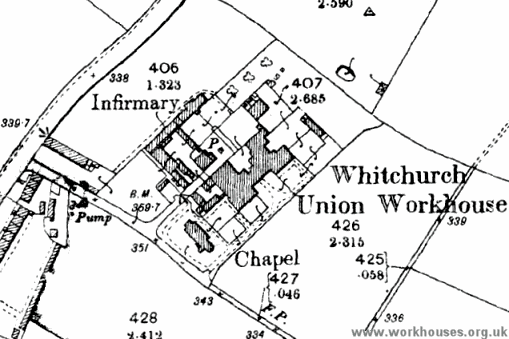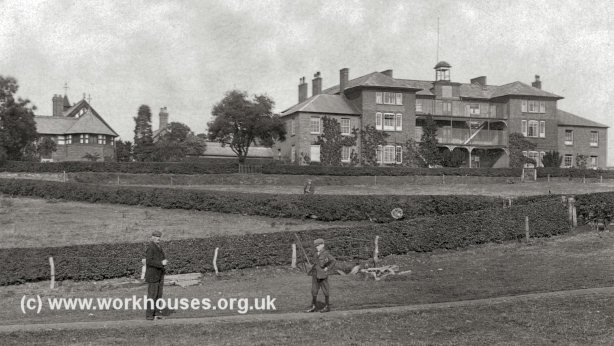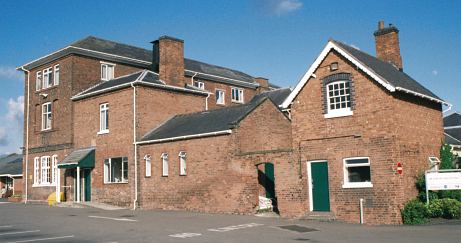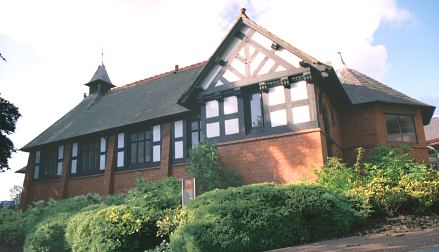Whitchurch, Shropshire
Up to 1834
In 1777, the Whitchurch parish workhouse, on Newtown, could hold up to forty inmates.
The success of the Shrewsbury Incorporation, formed in 1784, led to the creation of a number of other such incorporations in the region, including Atcham, Oswestry, Ellesmere, and Montgomery and Pool. Whitchurch was incorporated under a local Act in 1792. This gave it the powers, amongst other things, to erect a workhouse which it did in 1794 at a site on Claypit Street.
After 1834
Whitchurch's Local Act status made it immune from many of the provisions of the 1834 Poor Law Amendment Act. and it Directors decided that it should continue to operate independently. In 1852, however, they had a chage of heart and on 7 January a new Whitchurch Poor Law Union was, taking in parishes from Nantwich and other adjacent unions. The new union overseen by an elected Board of Guardians, 37 in number, representing its 25 constituent parishes as listed below (figures in brackets indicate numbers of Guardians if more than one):
Cheshire: Agden, Bickley, Bradley, Chidlow, Chorlton, Cuddington, Duckington, Edge, Hampton, Larkton, Macefen, Malpas (2), Marbury with Quoisley, Newton juxta Malpas, Norbury, Oldcastle, Overton, Stockton, Tushingham with Grindley, Wichaugh, Wigland, and Wirswall.
Shropshire: Ightfield, Whitchurch (12).
Flintshire: Iscoyd.
Later Addition: Threapwood (from 1894).
The population falling within the union at the 1851 census had been 11,400 with parishes ranging in size from Chidlow (population 12) to Whitchurch itself (5,976). The average annual poor-rate expenditure for the period 1851-54 had been £2,452 or 4s.4d. per head of the population.
After the new union was formed, the Claypit Street workhouse was enlarged. The original building was a symmetrical red-brick building facing to the south-east. Women and children were housed in the eastern part of the building and men in the western part. An infirmary block, now demolished, was added at the north. A casual ward block, complete with sleeping and work cells, stood at the western corner of the site. The workhouse location and layout are shown on the 1901 map below.

Whitchurch workhouse site, 1901.

Whitchurch workhouse from the south, early 1900s.
© Peter Higginbotham.

Whitchurch main building south-west wing from the west, 2001.
© Peter Higginbotham.
In 1883, a 150-seat chapel was built to the south of the workhouse at a cost of £639. Its design was in the then popular Arts-and-Crafts style.

Whitchurch chapel from the south-west, 2001.
© Peter Higginbotham.
The former workhouse later became Deermoss hospital and the surviving buildings now form part of Whitchurch Hospital which provides geriatric care.
Staff
Inmates
Records
Note: many repositories impose a closure period of up to 100 years for records identifying individuals. Before travelling a long distance, always check that the records you want to consult will be available.
- Shropshire Archives, Castle Gates, Shrewsbury, Shropshire SY1 2AQ. Please note that records may contain gaps or have access restrictions - please check before visiting. Main holdings: Guardians' minutes (1792-1930, with gaps); etc.
Bibliography
- Higginbotham, Peter The Workhouse Encyclopedia (2014, The History Press)
Links
- None.
Unless otherwise indicated, this page () is copyright Peter Higginbotham. Contents may not be reproduced without permission.


